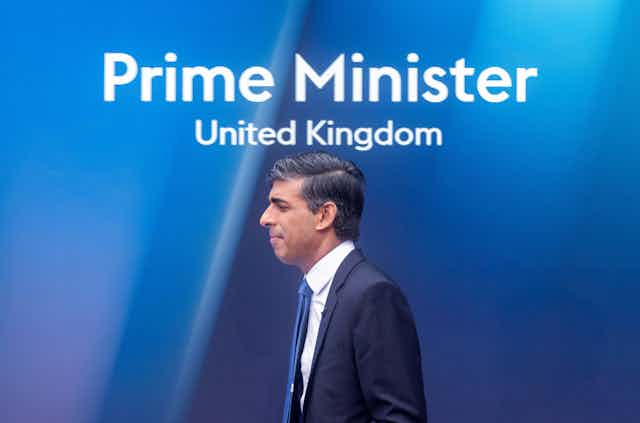So now we know. After weeks of speculation, Prime Minister Rishi Sunak has said he is “working on the assumption” that a general election will take place in the second half of this year. That’s just a few months before the latest possible date of January 28 2025.
The choice of an autumn election does make sense for Sunak and the Conservatives. With the polls showing the Labour opposition on a stable and substantial lead, it makes sense for the Conservatives to buy some time. The idea would be to try to make inroads into Labour’s lead before setting an election date.
Much rests on the fate of the economy. A year ago, Sunak promised to halve inflation, grow the economy and get debt falling. Independent analysis shows that inflation has halved, but less success on economic growth and falling debt.
Between now and the autumn, Sunak will hope that the economy shows signs of recovery. An autumn election will also give voters time to feel the economic benefits of the tax cuts that are anticipated in the spring, which could potentially provide the Conservatives with a boost in the polls.
Why ‘autumn’ means ‘October’
There are other reasons why an autumn 2024 election makes sense. During the post-war period, October has proven to be a popular month for elections – even though the last time an election was held in October was 1974. Although over recent decades, most general elections have taken place in the spring, between 1950 and 1974, four of the nine elections were held in October, with only one taking place in May.
No post-war general election has been held in August, September or November. If an election is held in the autumn, October would seem the most likely month if history is anything to go by.
There is also the British weather to consider. While there isn’t strong evidence to show that voters are less likely to turn out in bad weather, it is very much the received wisdom in the UK that this is the case, and given the decision comes down to Sunak, he may not think it worth risking winter weather. This would imply October over, say, November or December.
Historically, turnout in October elections has been similar to turnout in spring elections – and turnout is a major factor for the Conservatives. Age is now the most significant predictor of voting behaviour in UK general elections and age is linked to turnout.
The group most likely to vote for the Conservatives are those aged 65 and over – which is also the group most likely to vote at all. A higher overall turnout should therefore be a strategic goal for the Conservatives.
The 18-24 group is most likely to vote Labour but least likely to vote overall so an October vote is again a sound move. With hundreds of thousands of students returning to universities away from home in the autumn, and potentially not yet registered to vote at their term-time address, there is potential to minimise the younger vote.
A clash with the US election
An October election would mean the UK vote would take place just weeks ahead of the US election on November 5. The prospect of two of the world’s leading democracies going to the polls within weeks of each other is an exciting one for election enthusiasts.

On the other hand, there is the prospect of two new administrations coming into power around the same time, needing to find their feet quickly in an unstable geopolitical environment, following two elections that may be heavily influenced by polarisation and misinformation..
With the eyes of the world focused on a potentially divisive US election, Sunak may feel that a low-key campaign plays in to his hands, focusing on re-electing the incumbent to ensure stability.
Don’t rule out a spring election yet
The date for the election is not yet set in stone, however. Following the repeal of the Fixed-term Parliaments Act, the choice of election date lies in the hands of the prime minister.
The rollercoaster of British politics in recent years has shown us that much can change in six months. It would therefore be unwise to rule out a spring election, even after Sunak’s heavy hint.
The Labour opposition has accused Sunak of “squatting” in Downing Street and claims he is running scared, knowing that the polls show him on course for a loss. Sunak may therefore instead opt to call Labour’s bluff, signalling an autumn election in public but preparing for a May election in private. Sunak’s words do leave the door open for a spring election, as “working assumptions” can easily be changed.
Those who still think May is a possible election month will point to the announcement of an earlier than expected spring budget date. Headline-grabbing tax cuts, along with some positive economic forecasts may embolden the prime minister to take a gamble and move sooner rather than later.

